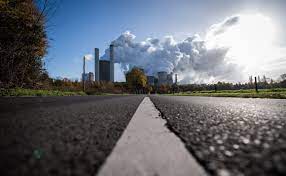Europe is spending millions to trap carbon. Where will it go?

Brussels: Salonit sits roughly 50 kilometers off the Gulf of Trieste, an Italian port nestled near the Adriatic Sea’s highest point. From there, Salonit can technically ship the carbon anywhere. But for now, it seems the only options are way up in the North Sea — a protracted (and, most notably, expensive) trip around the Continent.
Vuk said he’s willing to send the carbon wherever, but would of course prefer spots along the nearby Mediterranean and the Black Seas. For now, that’s not likely. So the North Sea it is.
“It might be acceptable to carry those costs for a short period of time until [closer] solutions are ready,” Vuk said.
The conundrum is a small example of a mounting problem for Europe as it races to establish the infrastructure needed to hit climate neutrality by 2050. The EU is heavily encouraging companies to invest in projects and technology that can either suck carbon from the air or prevent it from getting there in the first place. But that also means finding places to store all of that carbon.
So far, North Sea countries like Denmark and the Netherlands have dominated the industry — a fact the EU is aiming to change with new incentives and rules meant to create more storage across the bloc by 2030. But not everyone is convinced the plan will work, and some skeptics even wonder if carbon capture is really worth the sky-high investments required.
The stakes are high: Should the EU’s masterplan fail, landlocked, low-income European countries could be making investments now that never pay off, potentially taking down traditional manufacturing plants with them. That would leave the EU with an even greater economic divide — and another gap to fill in its green ambitions.
“There’s quite a risk, at least for industries in regions like Southern Central and Eastern Europe, where there are little project developments happening,” said Eadbhard Pernot, who leads the works on carbon capture for Clean Air Task Force, an NGO. “There’s a risk of deindustrialization in some parts of Europe and industrialization in other parts of Europe.”
Over the past year, a flurry of carbon-sucking vacuums and vaults have been announced in the wealthy region bordering the North Sea. The area is home to some of Europe’s largest oil and gas sites, providing it with a plethora of places to both grab and store carbon.
In March, a project dubbed Greensand launched with the promise of first capturing carbon in Belgium before shipping it to a depleted oil field in the Danish North Sea — a project that could store 8 million tons of CO2 by 2030. And in May, the Danish Energy Agency awarded renewable utility Ørsted a 20-year contract for the Kalundborg Hub, which touts that it will remove up to half a million tons of carbon from nearby heat and power plants starting in 2026.
The Netherlands is also keeping pace. The Porthos project is slated to store no less than 2.5 million tons in depleted gas fields. And big emitters like Air Liquide, Air Products, ExxonMobil and Shell have secured storage on the site starting in 2026, when Porthos goes online.
The northern dominance is so vast that research has shown Denmark alone could develop enough storage capacity to meet the EU’s goal to erect 50 million tons of CO2 storage by 2030 — which Brussels proposed in its Net Zero Industry Act (NZIA), a legislative effort to bolster the bloc’s manufacturing of green projects like wind turbines and solar panels.
The other nearby options are EU neighbors like Norway, Iceland and the U.K. While these sites might make sense geographically, they would also leave the EU increasingly dependent on outside countries for carbon storage — a future that Brussels wants to avoid.
The northern dominance is starting to freak out policymakers and industry leaders across the rest of Europe. They fear it will eventually erode their industrial competitiveness in a future marked by soaring carbon prices and fierce competition from outside Europe.
Currently, high-polluting manufacturers like steel and cement makers, which have to pay for their emissions under the bloc’s CO2 market, are getting a free pass for their carbon pollution — a decision made to keep EU-based industries from being overwhelmed by costs their competitors don’t always bear.
That won’t last forever, however. Last year, EU negotiators struck a deal to phase out the policy by 2034, hoping to drive up carbon prices and push industries to invest in lower-emission options, including carbon capture.
“Many are yet to grasp the consequences of the reform of the EU’s carbon market,” one EU diplomat, granted anonymity to speak candidly, told POLITICO.
Once these manufacturers are confronted with the full cost of their pollution, the diplomat argued, they will have an existential need for relatively cheap ways to absorb and store their carbon.
And those storage options are only cheap if they’re nearby.
The EU claims its plan will create these options. A proposal is in the works to spread carbon storage sites more evenly across Europe. The plan will also map out the transport needs for carbon to effectively get from where it is vacuumed up to its final resting place. The idea is to ensure that plants like Salonit aren’t left behind.
“To keep the costs of decarbonizing hard-to-abate industries at bay, Europe needs CO2 storage projects across the Continent,” said Eve Tamme, who chairs the Zero Emissions Platform, an organization advising the EU on carbon capture technology. “This helps to limit the need for expensive long-distance CO2 transportation routes.”
The European Commission, the EU’s executive in Brussels, also wants to encourage plants to invest in carbon trapping by guaranteeing that storage will be available.
Brussels has already called for countries to adopt a binding, EU-wide storage target of 50 million tons of CO2 by 2030 as part of its net-zero act. But the proposal has run into controversy over a clause that would force oil and gas producers to contribute to that goal.
Carbon storage leaders like Denmark and the Netherlands argued the provision would simply pull cash away from existing CO2 storage projects — benefiting fossil fuel giants in the process. Yet others countered that these are the exact companies that should be forced to help pack away the carbon after they spent years putting it in the sky.
In the end, Denmark and the Netherlands won, getting a narrowly written opt-out for oil and gas firms — but only if these quotas have been met with other projects.
Lina Strandvåg Nagell, senior manager at industrial decarbonization NGO Bellona, argued the compromise wouldn’t derail the overall ambition.
“This decision shows that storage will have to be developed across the EU,” she said.
And Brussels says the early signs are promising. In late November, Ditte Juul-Jørgensen, who heads the Commission’s energy department, said there were a growing number of carbon capture and storage projects in Southern and Eastern Europe in line to receive speedy approval and EU funding.
“Previously … projects were really situated mainly around the North Sea region,” ??she told an industry event. “But now they stretch from the Baltic to the Western and Eastern Mediterranean.”
But the question is whether the pace will be quick enough for people like Vuk, in Slovenia, and his fellow cement and steel compatriots across Central and Eastern Europe.
“Any action that would encourage” more carbon storage, he said, “is welcome.”





